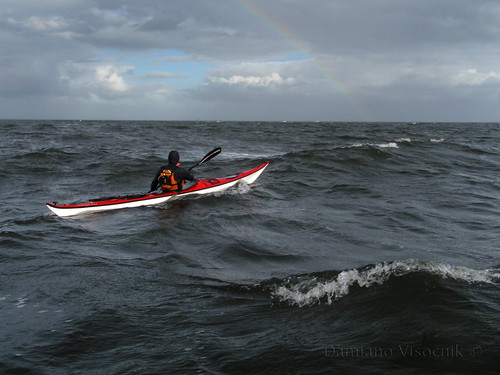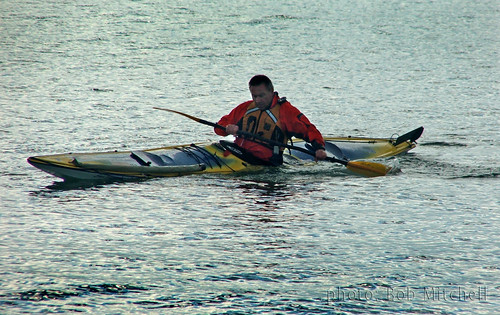In his pictures it is clearly demonstrated that a given kayak will behave very differently with a lighter or heavier load (read: paddler).
Obviously the biggest difference will be felt in kayaks that don't use rudders.
A skegged kayak is often designed to be more maneuverable when edged.
When I transitioned from a ruddered kayak to a skegged one I initially observed how a skilled paddler could spin my kayak so quickly around by edging it aggressively.
No amount of extended sweep strokes (without edging the boat) could make it turn as fast as what I observed.

Instructor Craig McSween aggressively edging
If I was not edging my kayak the stern would firmly remain deep below waterline preventing a quick turn.
Eventually I learned that for effective fast maneuvering of a skegged kayak edging was essential.
However that is not always true.
If a kayak was designed to optimally perform for a given load, a heavier kayaker might hinder the maneuverability when edging.
As demonstrated in Douglas images it seems that a heavier kayak will not allow that stern to release and spin.
The same could be said about a too light person/load in a kayak.
The stern might be not buried enough in the water creating a "loose tail".
Weathercocking could be a typical consequence of a larger kayak that is not loaded sufficiently.
I know of some kayakers that deem a Nordkapp hard to paddle when empty.

Could be that the their weight is not sufficient to fully engage the intended waterline?
Therefore is a Nordkapp LV less maneuverable for a heavier person?
I believe so.
The Nordkapp LV is designed with a particular weight in mind.
A heavier person will be pushing that hull deeper in the water and when the kayak is edged maybe the stern is not released as much as with a lighter paddler.
Two different kayakers will give the same boat a very different opinion!
Needless to say that skill level will probably be a very important factor when hearing a report on a given kayak but weight should certainly be just as an important element.

testing edge maneuverability
And just because your friend says that his/her kayak is really good for him/her, will that boat will be as good for you?
If you weigh substantially less/more then him/her, chances are that the kayak in question will behave very differently.

You've got it on the money. Hull shape and paddler weight have big impacts on the effectiveness of edging. Though I think the 'light paddler scenario' is less likely to be a problem than the 'heavier paddler scenario' as the light paddlers bow and stern will already be unlocked (or above the intended waterline) though the light paddler will have some weathercocking issues. Many have said that if your boat paddles better when weighted than your boat is too big. this is why it is very important to test paddle a boat (or as many boats as you can) before buying. Nice post.
ReplyDeletePO